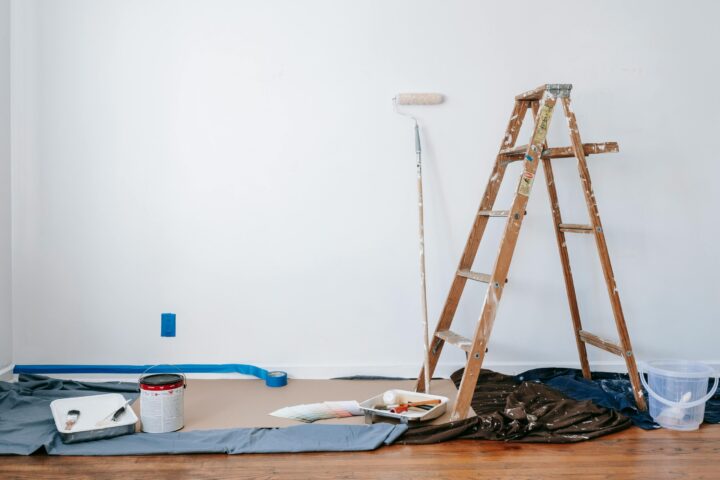The following contribution is from another author.
Ever walked into a room and just felt… better? It wasn’t the couch. It probably wasn’t the lighting. Most of the time, it’s the walls. A good paint job can make a space feel calm, bright, bold, or even bigger than it really is. But what’s crazy is how much most people don’t know about painting—even though it seems simple at first.
Everyone thinks painting is just dipping a roller in some color and slapping it on a wall. But pros have a bunch of tricks up their sleeves that make their work smoother, neater, and way longer-lasting. And once you hear them, it’s kind of impossible to not notice when someone skips them.
Here’s the real stuff that makes a difference—and how to avoid the little mistakes that ruin a good paint job.
It’s Not About the Color First
The first thing most people do when they want to paint is choose a color. But pros? They focus on the surface first. That means checking for dents, tiny holes, or peeling patches. Even the best paint won’t look smooth if the wall isn’t smooth.
Most pro painters spend way more time getting the wall ready than actually painting it. Sanding, patching, and cleaning the surface isn’t the fun part, but it’s what makes the paint look perfect later. If the wall feels rough, or if there’s dust and grease on it, the paint might peel or dry unevenly.
That’s why a lot of people choose to hire expert Painters Gold Coast, or those elsewhere, when they want the job done right the first time. The professionals understand how important prep work is and use the right tools and techniques from the start. That extra attention to detail can save you a ton of time and frustration.
Don’t Trust the Paint Chip
Those tiny paint samples in hardware stores? They lie. Okay, maybe not on purpose, but they don’t tell the full story. The color on that little card looks totally different once it’s on a big wall with real lighting.
Here’s why: lighting in your room affects the way color looks. A soft beige might look warm in a store but turn gray at home if the room doesn’t get much sunlight. Paint also changes as it dries. Some colors dry darker, and some show weird undertones nobody saw coming.
That’s why pros always test patches on the actual wall, in natural and artificial light. It takes a little longer, but it means fewer regrets after the job’s done. If you’re doing it yourself, always test at least two shades before making a final call.
Two Coats Isn’t a Rule—It’s a Shortcut
Most people say “you only need two coats.” That’s true if the wall is already light and the paint is high-quality. But if you’re going from dark blue to white? Two coats won’t cut it. You’ll either end up with shadows of the old color showing through or patchy spots that look messy.
Professional painters often use a primer, especially when changing from dark to light or when painting raw materials like bare wood or new drywall. Primer helps the paint stick better and makes the color more even.
Skipping primer or rushing through extra coats might save a few bucks at first—but in the end, it usually means repainting sooner. And that gets expensive.
Tools Actually Matter (A Lot)
Cheap rollers and brushes are fine for a one-time art project. But for a real paint job, they’re kind of a disaster. Low-quality rollers leave lint on the wall, and weak brushes can’t make sharp lines or even coats.
Here’s a secret: professionals don’t just use better tools—they use the right ones for each job. There are angled brushes for corners, thick rollers for textured walls, and special handles that make ceiling work way easier.
Also, taping off edges isn’t always a must for pros, because they’re trained to cut in (which means painting clean lines by hand). But for regular people, using painter’s tape can still be super helpful—as long as it’s removed before the paint fully dries. If you wait too long, it can rip off parts of the paint.
Temperature Can Ruin the Finish
Most people don’t think about this, but paint is kind of sensitive. It dries best in temperatures between 10°C and 30°C (50°F to 85°F). If it’s too hot or humid, the paint stays sticky and might bubble. If it’s too cold, it gets thick and doesn’t dry right.
That’s why pros check the weather before outdoor jobs and use fans or dehumidifiers indoors when needed. They also wait the right amount of time between coats. Rushing it can cause the layers underneath to lift, creating bumps or peeling later.
Not All Paint Is Created Equal
Some paints are made for walls. Some are for trim, ceilings, or outdoor use. Mixing them up? Bad idea. Each type is built to do something specific. For example, ceiling paint is flat so it hides light reflections. Wall paint might be satin or semi-gloss, which is easier to clean.
Then there’s oil-based vs. water-based paint. Water-based is easier to work with and clean up, but oil-based lasts longer and holds up better in certain spots—like doors or high-traffic areas. Knowing which to use (and where) is something pros figure out based on the room and how it’s used.
Paint Smell Doesn’t Mean It’s Done
A lot of people think once the smell fades, the paint is cured. Not true. Paint might feel dry after a few hours, but it takes days or even weeks to fully harden.
That means furniture can still scratch it, tape can pull it off, or cleaning it too soon might ruin the finish. Professional painters always give clear instructions on how long to wait before touching, washing, or hanging things back up. That part matters just as much as the paint itself.
Final Thoughts to Keep in Mind
Painting sounds easy until you’ve actually done it. There’s a lot more behind smooth walls and crisp lines than people realize. From prepping the surface to choosing the right tools and waiting the right amount of time, each step matters way more than it seems.
If it’s a small room or just an accent wall, it might be fun to try on your own. But for a full house or anything with tricky spots, getting help from pros can save time and stress.
It’s not just about making a room look better—it’s about doing it in a way that stays looking better. And now, at least, all those “secrets” don’t have to stay secret anymore.
Got a space that’s driving you nuts? Sometimes all it needs is a change of color.
















